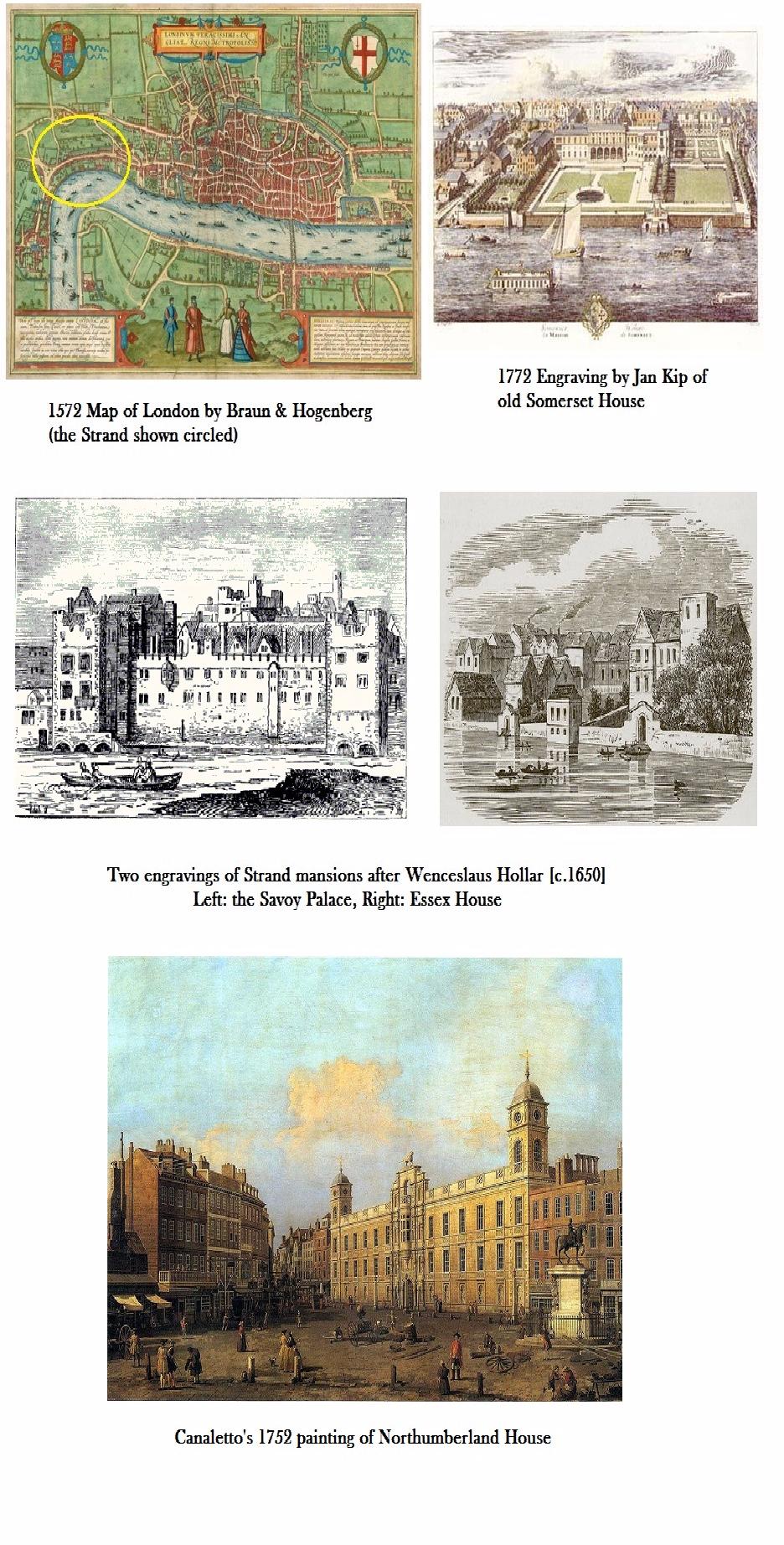ON THE WATERFRONT - THE GREAT MEDIEVAL & TUDOR MANSIONS OF THE STRAND
Apart from being the first red square on a UK monopoly board, the Strand was the principle thoroughfare that connected the walled City of London with the royal palace at Westminster. This famous London street originally ran along the north bank of the Thames (the word ‘strand’ actually means ‘beach’ or ‘riverbank’ in Old English) and for 400 years it was the address of choice for the most powerful noblemen in England. The grandest houses were built on the south side of the Strand, with gardens stretching to the water’s edge, and included:
Essex House - built as an Outer Temple of the Knights Templar, the property passed to the Hospitaller Knights of St John when the Templars were dissolved in 1312. Two centuries later, when all England’s monasteries were dissolved, Henry VIII gave the building to William, Baron Paget and in 1563 Paget’s House passed to Robert Dudley, Earl of Leicester. In 1588 Leicester House became Essex House after being inherited by Robert Devereux, 2nd Earl of Essex but the building was demolished around 1674. Essex Street, leading to the Strand, was built on the location by speculator Nicholas Barbon.
Arundel House - was the town house of the Bishops of Bath & Wells but was seized by the crown and passed to William FitzWilliam, the Earl of Southampton, in 1539. In 1545 Thomas Seymour (Jane’s brother) acquired the property but after his fall and execution, the property was sold to Henry FitzAlan, Earl of Arundel. Following the Great Fire of London in 1666, Arundel House became the meeting place of the Royal Society but the house was demolished in 1678 to make way for Arundel Street.
Somerset House - was built by another Seymour, Edward, who was Duke of Somerset and regent of England from 1547 to 1549. To build his sumptuous palace, Edward demolished three taverns and a church but after his execution, the house became a residence for the future Elizabeth I. On her accession to the throne in 1558, she returned part of the house to the Seymour family. Later, the remainder became a meeting place for the Royal Society. After Elizabeth's death in 1603, the house was owned by Anne of Denmark, wife of James VI/I, but in 1645, during the Civil War, it was taken over by Parliament. In 1775, Somerset House was rebuilt to accommodate several government departments including the Stamp Office (the forerunner of the Inland Revenue) but today the buildings are home to the Courtauld Institute of Art and King's College School of Law.
Savoy Palace - was the London residence of John of Gaunt, Plantagenet power broker and uncle of Richard II. In the 14th century the Savoy was the most magnificent mansion in England so it was hardly surprising that it was razed to the ground during the 1381 Peasants' Revolt (which was caused, at least in part, by the poll tax introduced by John of Gaunt). In 1512 the house was rebuilt to house the Savoy Hospital for the poor but it gradually became derelict. The ruins were demolished in 1820 to make way for the approach to Waterloo Bridge and the Savoy Hotel.
Cecil House (also called Exeter House or Burghley House) – the original house, built in the 16th century for Elizabeth I’s Secretary of State Lord Burghley, was demolished in 1676 and the Exeter Exchange erected in its place. In 1773 the buildings were converted into a menagerie which housed lions, tigers, monkeys, a hippopotamus and, later, an elephant named Chunee. In 1826, Chunee broke out of her cage and had to be destroyed; shortly afterwards the menagerie was moved to the Surrey Zoological Gardens and replaced by Exeter Hall, which became a centre for Evangelical meetings. The Hall in its turn was demolished in 1907 and the site is now occupied by the Strand Palace Hotel.
Durham House - the historic London residence of the Bishop of Durham, was built c.1345 and was briefly owned by the Boleyn family before being demolished in 1660. Durham Street and the Adelphi Buildings were built on the site.
York House - was built c.1237 for the Bishop of Norwich before passing to the crown during the Reformation. In 1556 the house was given to the Archbishopric of York but in 1620 it was acquired by James I’s favourite George Villiers, 1st Duke of Buckingham. In 1672 Buckingham’s descendants sold the site to developers, who promptly demolished the house, but several of the new streets (George St, Villiers St, Duke St and Buckingham St) commemorate the former owners.
Northumberland House - originally built for the Earls of Northampton, this was the last of the Strand’s great mansions to be demolished. In the 1640s the house was sold to the Duke of Northumberland (for £15,000) and his descendants continued to reside there long after the Strand had ceased to be a fashionable place to live. Successive Dukes stubbornly refused to leave their family’s London home but in 1866 the government forced the 5th Duke to sell to make way for a new road (Northumberland Avenue). However, the £500,000 (worth £39 million today) he received for the site must have eased his pain!
